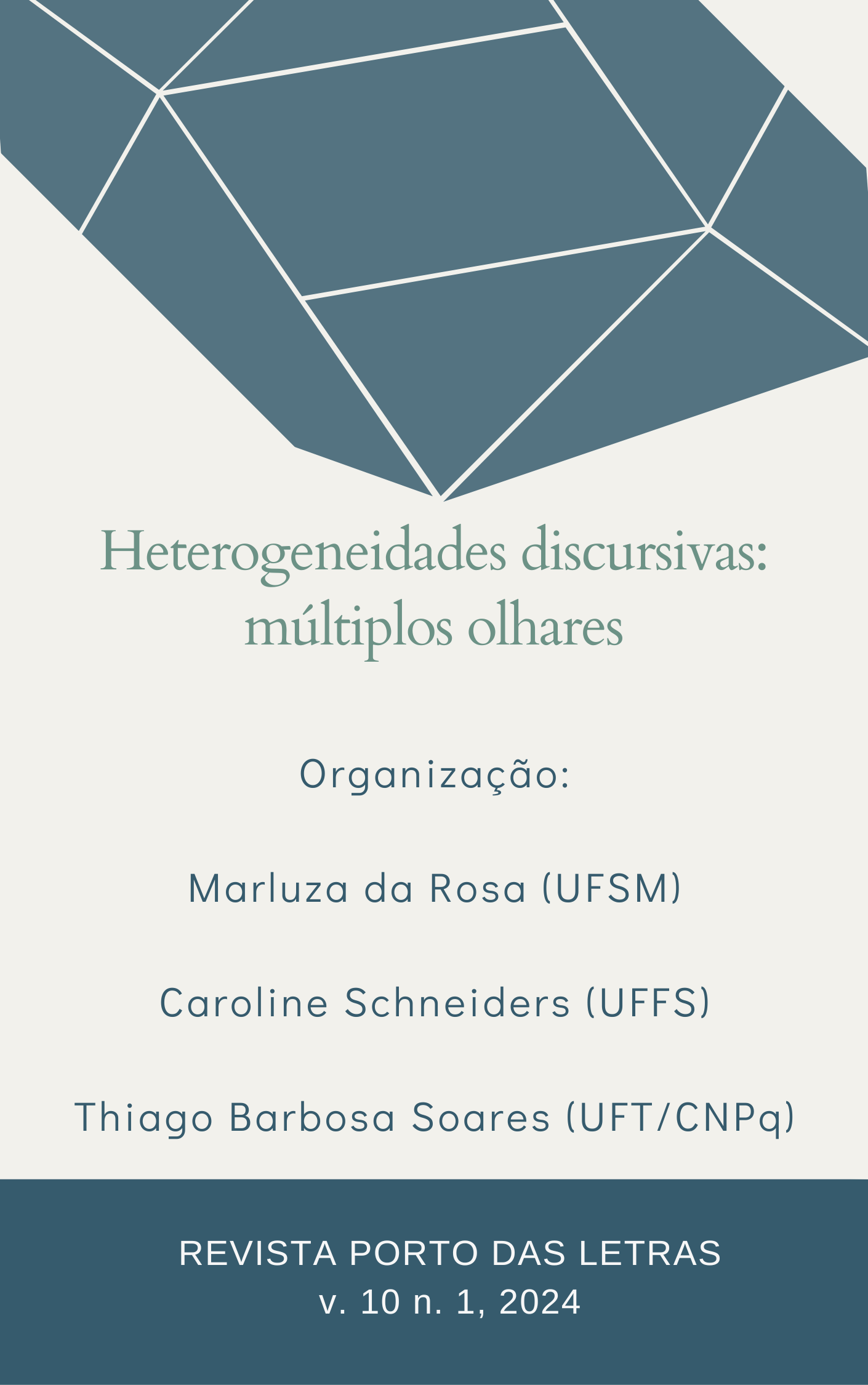ESTRATÉGIAS DE LEITURA DO GÊNERO CHARGE
DIALOGICIDADE E MULTISSEMIOSE NA CONSTRUÇÃO DOS SENTIDOS
DOI:
https://doi.org/10.20873/10.20873-2024-hdAbstract
This research aims to analyze the social functioning of the cartoon genre and its use as a reading strategy in the context of Basic Education, in elementary school. The text is an excerpt from a monographic work carried out in the Portuguese Language Language and Codes Course. As developments of the general objective, we have the following specific objectives: a) to investigate the importance of multisemiosis as a reading strategy for the cartoon genre; b) analyze dialogical and ideological relationships in the construction of meanings in the cartoon; c) reflect on the importance of the cartoon genre as an object of teaching in basic education. The problem is: what aspects of the social functioning of the cartoon genre and how can it be used as a reading teaching strategy in the context of Basic Education. For theoretical discussion, we have Bakthin (2009; 2011); Marcuschi (2002;2004); Rojo and Barbosa (2015); Miller (2009), among others. The research is qualitative, bibliographic and documentary in nature. The corpus is made up of texts belonging to cartoons taken from Blog do Amarildo. Four cartoons from this blog were selected to analyze these texts with themes related to the pandemic. As results, we highlight the importance of the cartoon genre as a teaching object for the formation of a critical reader with regard to political-journalistic events. We also emphasize the need for a reading that includes strategies aimed at the functional aspects of the cartoon genre, such as place of circulation, multisemiotic character, dialogic and ideological aspects.
References
ALVES FILHO, Francisco; SANTOS, Eliane, Pereira. O tema da Enunciação e o tema do gênero no comentário online. Revista Fórum Linguístico, Florianópolis, v.10, n 2, p.78-90, abr./jun.2013.
ANGELO, Cristiane M. Pianaro; MENEGASSI, Renilson José. Manifestações de compreensão responsiva em avaliação de leitura. Revista Linguagem e Ensino. Pelotas, v. 14, nº1, p. 201-221. jan/jun, 2011.
BAKHTIN, M. M. (VOLOHINOV, V. N.). Marxismo e filosofia da linguagem: problemas fundamentais do método sociológico da linguagem. 13ª ed. São Paulo: Hucitec, 2009.
BAKHTIN, Mikhail. Estética da criação verbal. 6. ed. São Paulo: Martins Fontes, 2011.
BAZERMAN, Charles. Atos de fala, gêneros textuais e sistema de atividades: como os textos organizam atividades e pessoas. In: Dionísio, Ângela Paiva; Hoffnagel, Judith Chambliss (org.). Gêneros textuais, tipificação e interação. São Paulo: Cortez, 2006. p. 19-36.
BAZERMAN, Charles. Gêneros textuais, tipificação e interação. Tradução Judith Hoffnagel. São Paulo: Cortez, 2005.
BRASIL. Base Nacional Comum Curricular: Educação Infantil e Ensino Fundamental. Brasília: MEC/Secretaria de Educação Básica, 2017.
COSCARELLI, C. V., RIBEIRO, Ana Elisa (Orgs.). Letramento digital: aspectos sociais e possibilidades pedagógicas. 2. ed. Belo Horizonte: Autêntica, 2005.
COSCARELLI, C. Alfabetização e letramento digital. In: Letramento Digital: aspectos sociais e possibilidades pedagógicas. COSCARELLI, Carla Viana; RIBEIRO, Ana Elisa (Org). Belo Horizonte: Ceale; Autêntica, 2011.
DIONISIO, Ângela Paiva. Gêneros multimodais e multiletramento. In: KARWOSKI, Acir. Mário et al (organizadores). Gêneros textuais: reflexão e ensino. 3.ed. – Rio de Janeiro : Nova Fronteira, 2008.
MARCUSCHI, L. A. Gêneros textuais: definição e funcionalidade. In: DIONÍSIO, Ângela Paiva; MACHADO, Anna Rachel; BEZERRA, Maria Auxiliadora. (Org.). Gêneros Textuais e Ensino. Rio de Janeiro: Lucerna, 2002.
MARCUSCHI, L.A. Gêneros textuais emergentes no contexto da tecnologia digital. In: MARCUSCHI, L.A.; XAVIER, A.C. Hipertexto e gêneros digitais: novas formas de construção do sentido. Rio de Janeiro: Lucerna, 2004. p.13-67.
MENEGASSI, Renilson José. Aspectos da responsividade na interação verbal. Revista Línguas e Letras, v. 10, nº 18. p. 147-170. 1º sem. 2009.
MILLER, Carolyn. Estudos sobre gênero, agência e tecnologia. Recife: UFPE, 2009.
OLIVEIRA, M.L.S. de. Charge: imagem e palavra numa leitura burlesca do mundo. In: AZEREDO, J.C. de. (Org.). Letras e comunicação: uma parceria no ensino de língua portuguesa. Petrópolis, RJ: Vozes, 2001.
ROJO, Roxane (Org.). Escola conectada: os multiletramentos e as TICs. 1 ed. São Paulo: Parábola, 2013.
ROJO, Roxane; ALMEIDA, Eduardo de Moura (Orgs.). Multiletramentos na escola. São Paulo: Parábola Editorial, 2012, 264 p. (Estratégias de ensino).
ROJO, Roxane; Letramentos múltiplos, escola e inclusão social. São Paulo: Parábola Editorial, 2009. 127p
ROJO, Roxane; MOURA, Eduardo. Letramentos, mídias, linguagens. São Paulo: Parábola Editorial, 2019.
ROMUALDO, E. C. Charge jornalística: intertextualidade e polifonia – um estudo de charges da Folha de S. Paulo. Maringá: Eduem, 2000.
SOARES, Magda. Letramento: um tema em três gêneros. Belo Horizonte: Autêntica, 2002.
ZACHARIAS, Valéria Ribeiro de Castro. Letramento digital: desafios e possibilidades para o ensino. In: Tecnologias para aprender. COSCARELLI, Carla Viana (Org). São Paulo: Parábola editorial, p. 15-26, 2016.
Downloads
Published
Versions
- 2024-05-19 (2)
- 2024-05-19 (1)
How to Cite
Issue
Section
License
Os autores concordam com os termos da Declaração de Direito Autoral, que se aplicará a esta submissão caso seja publicada nesta revista (comentários ao editor podem ser incluídos a seguir).

